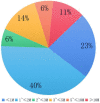Evaluation of the clinical utility of extended non-invasive prenatal testing in the detection of chromosomal aneuploidy and microdeletion/microduplication
- PMID: 37644576
- PMCID: PMC10466692
- DOI: 10.1186/s40001-023-01285-2
Evaluation of the clinical utility of extended non-invasive prenatal testing in the detection of chromosomal aneuploidy and microdeletion/microduplication
Abstract
Background: With the development of whole-genome sequencing technology, non-invasive prenatal testing (NIPT) has been applied gradually to screen chromosomal microdeletions and microduplications that cannot be detected by traditional karyotyping. However, in NIPT, some false positives and false negatives occur. This study aimed to investigate the applicability of extended NIPT (NIPT-PLUS) in the detection of chromosomal aneuploidy and microdeletion/microduplication syndrome (MMS).
Methods: A total of 452 pregnancies that underwent prenatal diagnostic testing (amniocentesis or chorionic villus sampling) by chromosomal microarray analysis (CMA), were screened by NIPT-PLUS from the peripheral blood sample of the pregnant women. The results of the two tested items were compared and analysed.
Results: Of the 452 cases, 335 (74.12%) had positive CMA results, and 117 (25.88%) had no abnormal results. A total of 86 cases of trisomy 21, 18 and 13 and sex chromosome aneuploidy (SCA) were detected by CMA and NIPT-PLUS, with a detection rate of 96.51% (83/86). Among them, the detection rates of T18, T13; 47, XXY; 47, XXX and 47 XYY were 100%, and the detection rates of T21 and 45 XO were 96.55% and 90%, respectively. The detection sensitivity of rare chromosomal trisomy (RAT) was 80% (4/5). The positive predictive values of NIPT-PLUS for chromosome aneuploidy T21, T18 and T13 and for SCA and RAT were 90.32%, 87.50%, 25.00%, 88.89% and 50%, respectively. A total of 249 cases (74.32%) of chromosomal MMS were detected by CMA. The detection rate of NIPT-PLUS was 63.86% (159/249), and 90 cases (36.14%) were missed. The larger the MMS fragment, the higher the NIPT-PLUS detection sensitivity. In addition, most small fragments were of maternal origin.
Conclusion: The comparison between the CMA and NIPT-PLUS techniques shows that NIPT-PLUS has high sensitivity for detecting chromosomal aneuploidy and chromosomal copy number variations (CNVs) with fragments > 5 M. However, the sensitivity of CNV for fragments < 5 M is low, and the missed detection rate is high. Additionally, confined placental mosaicism and foetal mosaicism are the key factors causing false negatives in NIPT-PLUS, while maternal chromosomal abnormalities and confined placental mosaicism are key contributors to false positives, so appropriate genetic counselling is especially important for pregnant women before and after NIPT-PLUS testing.
Keywords: Chromosomal microarray analysis (CMA); Microdeletion/microduplication (MMS); NIPT-PLUS; Rare chromosomal trisomy (RAT); Sex chromosome aneuploidy (SCA).
© 2023. BioMed Central Ltd., part of Springer Nature.
Conflict of interest statement
All of the authors had no any personal, financial, commercial, or academic conflicts of interest separately.
Figures
Similar articles
-
Expanding the application of non-invasive prenatal testing in the detection of foetal chromosomal copy number variations.BMC Med Genomics. 2021 Dec 11;14(1):292. doi: 10.1186/s12920-021-01131-6. BMC Med Genomics. 2021. PMID: 34895207 Free PMC article.
-
Non-invasive prenatal test findings in 41,819 pregnant women: results from a clinical laboratory in southern China.Arch Gynecol Obstet. 2023 Sep;308(3):787-795. doi: 10.1007/s00404-022-06908-3. Epub 2023 Jan 5. Arch Gynecol Obstet. 2023. PMID: 36602559 Review.
-
The role of non-invasive prenatal testing and ultrasound in prenatal screening of fetal chromosomal abnormalities in singleton: a retrospective study.Ann Transl Med. 2023 Jan 31;11(2):111. doi: 10.21037/atm-22-6343. Ann Transl Med. 2023. PMID: 36819517 Free PMC article.
-
Clinical application of expanded noninvasive prenatal testing for fetal chromosome abnormalities in a cohort of 39,580 pregnancies.Am J Med Genet A. 2022 May;188(5):1426-1434. doi: 10.1002/ajmg.a.62657. Epub 2022 Feb 2. Am J Med Genet A. 2022. PMID: 35107205
-
Non-invasive prenatal testing for fetal chromosomal abnormalities by low-coverage whole-genome sequencing of maternal plasma DNA: review of 1982 consecutive cases in a single center.Ultrasound Obstet Gynecol. 2014 Mar;43(3):254-64. doi: 10.1002/uog.13277. Epub 2014 Feb 10. Ultrasound Obstet Gynecol. 2014. PMID: 24339153 Review.
Cited by
-
Expanded non-invasive prenatal testing offers better detection of fetal copy number variations but not chromosomal aneuploidies.PLoS One. 2025 Jan 24;20(1):e0312184. doi: 10.1371/journal.pone.0312184. eCollection 2025. PLoS One. 2025. PMID: 39854358 Free PMC article.
-
A retrospective analysis of 6942 amniocentesis cases.BMC Pregnancy Childbirth. 2025 Aug 12;25(1):838. doi: 10.1186/s12884-025-07992-4. BMC Pregnancy Childbirth. 2025. PMID: 40797307 Free PMC article.
-
Early Non-Invasive Prenatal Testing at 6-9 Weeks of Gestation.Genes (Basel). 2024 Jul 8;15(7):895. doi: 10.3390/genes15070895. Genes (Basel). 2024. PMID: 39062674 Free PMC article.
-
Retrospective study on NIPT or NIPT plus combined with ultrasound in screening fetal chromosomal abnormalities.Sci Rep. 2025 Apr 15;15(1):12859. doi: 10.1038/s41598-025-97230-w. Sci Rep. 2025. PMID: 40229386 Free PMC article.
-
Healthcare professionals' perspectives on and experiences with non-invasive prenatal testing: a systematic review.Hum Genet. 2025 Apr;144(4):343-374. doi: 10.1007/s00439-025-02736-y. Epub 2025 Apr 9. Hum Genet. 2025. PMID: 40205233 Free PMC article.
References
-
- Miller DT, Adam MP, Aradhya S, Biesecker LG, Brothman AR, Carter NP, et al. Consensus statement: chromosomal microarray is a first-tier clinical diagnostic test for individuals with developmental disabilities or congenital anomalies. Am J Hum Genet. 2010;86(5):749–764. doi: 10.1016/j.ajhg.2010.04.006. - DOI - PMC - PubMed
MeSH terms
LinkOut - more resources
Full Text Sources




